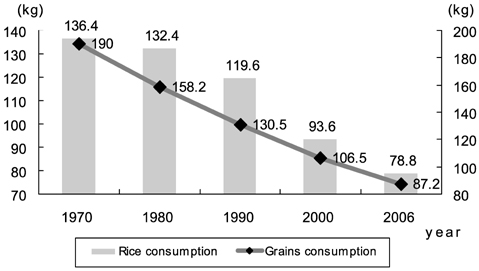Nutr Res Pract.
2007 Mar;1(1):8-13.
Cultural perspectives and current consumption changes of cooked rice in Korean diet
- Affiliations
-
- 1Korea Food and Nutrition Foundation, Seoul 121-020, Korea. kfnf01@paran.com
- 2Professor Emeritus, Department of Food and Nutrition, Ewha Woman's University, Seoul 120-750, Korea.
Abstract
- Cooked rice is a staple food for Koreans which provides more than 60% of daily required energy. In 1960's, Koreans ate 600 g-800 g of cooked rice per meal and the energy obtained from cooked rice was almost more than 80% of the daily intake of energy. However, as the economy of Korea improved, the major industry has been shifted from agriculture to various manufacturing industries and the export of those products has been increased thus increasing the national income but decreasing the farming population and thus rice consumption have been decreased. It has been said that the decreased rice consumption is caused solely by decreased farming population but it can also be said that the decreased farming population is caused by decreased rice consumption.
Keyword
Figure
Reference
-
1. Im Hyo-Jae. Historical origins of rice farming culture in Korea. 2001. Korea: Hak-yeon publishing.2. Yoon Seo Suk. History of food culture in Korea. 2001. Korea: Shin-kwang publishing.3. Ministry of Health and Welfare. 2005 National Health and Nutrition Survey-Nutrition Survey-. 2006. Korea:4. Korea National Statistical Office. Social indicators in Korea. 2006. Korea: 323.5. Ministry of Health and Welfare. Yearbook of health and welfare statistics. 2006. Korea: 51–52.6. Korea National Statistical Office. 2005 Statistical data of the cause of death. 2006. Korea:7. Korea National Statistical Office. 2006 the rice consumption per capita. 2007. Korea:
- Full Text Links
- Actions
-
Cited
- CITED
-
- Close
- Share
- Similar articles
-
- Nutritional Evaluation and Its Relation to the Risk of Metabolic Syndrome according to the Consumption of Cooked Rice and Cooked Rice with Multi-grains in Korean Adults: Based on 2007-2008 Korean National Health and Nutrition Examination Survey
- A Study on the Menu Patterns of Residents in Kangbukgu( I ) -Whole Menu Patterns and Menu Patterns by Meal
- A Case of Rice Allergy Caused by Thin Rice Porridge during the Weaning Period
- Effects of Food Consumption Monitoring Using Modified Rice Bowls on Food Intake, Satiety Rate, and Eating Rate
- Influence of Visual Differences in Bowl Size and Types on Dietary Intake of Female College Students with Normal Weight



